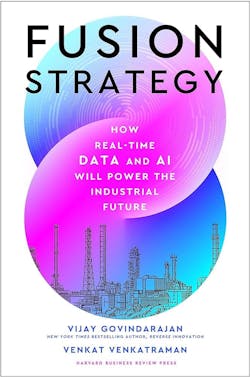Deere, Bosch, Siemens—Manufacturers Are Using Data and AI Holistically to Drive Customer Value
The traditional model—reliant on reactive services delivered by customer-service representatives and authorized third-party contractors with limited data and insights—needs to be revised. To thrive in today’s competitive environment, manufacturers must move beyond mere machine efficiency and focus on directly contributing to customer profitability.
Our research, published in “Fusion Strategy: How Real-Time Data and AI Will Power the Industrial Future,” highlights this critical shift. We found that many companies claiming to be service-focused need more real-time data on how their equipment directly impacts customer profitability. While they may possess high-level data enabling broad business assessments, they cannot tailor their offerings to optimize individual customer performance. This limitation stems from the siloed data systems prevalent in the analog world. To overcome this hurdle, companies must transform the analog machines they sell into fusion products capable of transmitting real-time data to central locations. These fusion products form the foundation for fusion services, the next generation of industrial services.
For example, Deere tractors can send their performance data back to the operations center. Caterpillar has deployed apps to help dealers and customers track machine health in realtime and take corrective action.
Some may question the feasibility of this transition. However, numerous examples showcase the ongoing transformation of industrial products into fusion products. Automobiles are now essentially “computers on wheels,” connected to cloud networks and constantly collecting data. Similarly, tractors have become "farm-based computers" linked to precision agriculture cloud systems. This trend extends to robots, trucks, buildings, solar panels, and other industrial equipment. As witnessed at recent industry trade shows, product announcements increasingly emphasize digital features and cloud connectivity.
For industrial companies, the opportunity lies in designing and manufacturing fusion products and leveraging the real-time data they generate to deliver compelling services that unlock hidden value for customers. Here are four essential steps for companies to emerge as leaders in the fusion services space:
Co-create fusion services with customers.
The main point of departure is to design the services with the customers to address the significant drivers of customer profitability. Expanding the reach of fusion services into core customer operations presents a considerable challenge. Companies must convince buyers of their unique value proposition to succeed; this hinges on three key elements. The first is deep domain knowledge—demonstrate that you have a comprehensive understanding of customers’ industries, business models, drivers of profitability, and specific ways your products could enhance customer profitability. The second is continually learning from customer data--the ability to leverage real-time data streams across the customer base to gain deeper customer insights and proactively improve service offerings. The third is real-time, actionable recommendations—your capacity to translate data-driven insights into actionable recommendations that optimize your machine performance and contribute to customer profitability. In essence, you are co-architecting the shape of services with your customers.
For example, Rolls-Royce offers "Power by the Hour" agreements for its aircraft engines.This approach ensures that Rolls-Royce is responsible for the maintenance and performance of its engines, with costs linked to the hours that the engines are in operation.This model aligns the company's incentives with those of its customers. And it goes beyond preventive maintenance.
Build Al and data science for profitable services.
Implementing a robust fusion services strategy necessitates the development of strong organizational capabilities in artificial intelligence (AI) and data science. It starts with recognizing that digital twins are not limited to only the design and manufacturing stage but extend well into the customer. We strongly recommend that industrial companies consider three-part digital twins integrating product, process and performance to use real-time field data best.
Think of it as an end-to-end digital representation that links how a product is designed, manufactured and delivered to customers.Instead of having three parts of the company with different functions each responsible for their operations, one can immediately tie data on a machine malfunctioning to the source. Did it happen due to design choice? Suppliers’ actions? Specific production lines?
The goal should be to transform raw data into actionable recommendations that drive customer value and create a strong return on investment (ROI) for the service. There may be specific recommendations, for instance, on fine-tuning machinery under particular conditions, such as a Deere tractor for different climate conditions or different types of crops. While customers are typically limited to knowledge from their own operations, the manufacturer can learn from their customers and develop more authoritative recommendations.
Companies must assemble a team of skilled professionals—a combination of manufacturing and digital experts who understand the business cases that could be delivered with data and AI—adept at data collection, analysis and modeling and know the impact of recommendations on customer profitability.
Start small and accelerate fast.
How do you effectively ramp up fusion services? This reprioritization of resources is always challenging in established companies. Start with a handful of eager customers to create the minimum viable fusion services. For example, for an airplane engine maker that might involve optimizing the engines for different flight conditions along one route for one type of aircraft, then progressively expanding to the entire aircraft fleet.
This is a prototype of how to co-create the service offering with eager customers, with full details (supported by simulations where necessary) of how data network effects flow into the construction of service datagraphs, how algorithms on such datagraphs yield actionable prescriptions and how recommendations translate into business benefits. This will reveal valuable insights into the opportunities and challenges of scaling up with these customers. Valuable lessons are learned even if eager customers are unwilling to entertain the services on a longer-term basis at the end of the pilot project. A phased approach allows companies to examine the role of partnerships for data interoperability. Acceleration plans should also recognize the importance of potential alliances or acquisitions.
Show me the money, but share it equitably.
Industrials must share the value they create with customers to unlock deeper engagement. This means moving beyond average performance gains to actionable insights from real-time data and AI. Initially, unbundled pricing allows customers to pay for the product alone and opt into fusion services as they see value. Industrials should carefully compare their fusion services against third-party providers, offering clear advantages through integrated digital twins. As they prove their value, bundled pricing becomes viable. Network effects inherent in bundled offerings can outpace competitors reliant on generic solutions. Contracts focused on enhancing data collection can further strengthen these offerings even without direct revenue. Recognize that dealers and distributors remain crucial for service delivery. Their local knowledge and industrial data form a powerful bond that benefits all relevant stakeholders.
About the Author
VG Govindarajan
Vijay Govindarajan (VG) is the Coxe Distinguished Professor at Dartmouth College’s Tuck School of Business and faculty partner at the Silicon Valley incubator Mach49. He is a New York Times and Wall Street Journal bestselling author. His latest book is Fusion Strategy. His Harvard Business Review articles “Engineering Reverse Innovations” and “Stop the Innovation Wars” won McKinsey Awards for best article published in HBR. His HBR articles “How GE Is Disrupting Itself” and “The CEO’s Role in Business Model Reinvention” are HBR all-time top-50 bestsellers.
Venkat Venkatraman
David J. McGrath Jr. Professor in Information Systems, Boston University
I research how established companies recognize and respond to digital technologies. We have seen the first-wave of transformation in asset-light settings such as software, music, media and entertainment and we are likely to see asset-heavy, information-rich sectors such as automotive, logistics, healthcare. agriculture and logistics go through significant shifts. How could today’s industry leaders defend their business models while adapting to the digital future? I am working on extending the work that has been published in my 2016 book, "The Digital Matrix: New Rules for Business Transformation through Technology" into a new book focused specifically on asset-heavy sectors.
My new book, coauthored with Vijay Govindarajan, is Fusion Strategy: How Real-Time Data and AI Will Power the Industrial Future.

